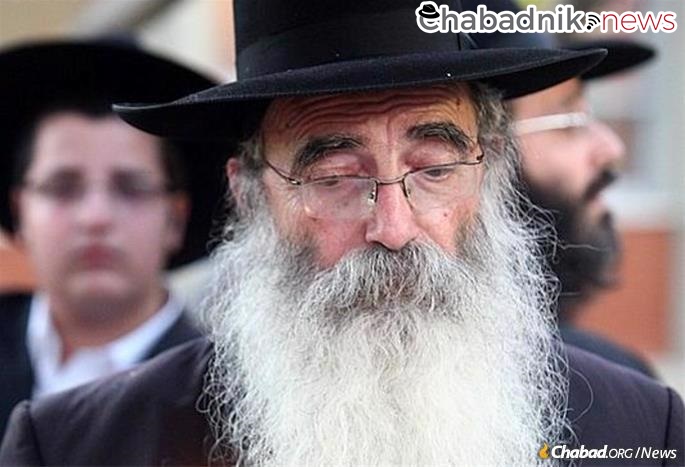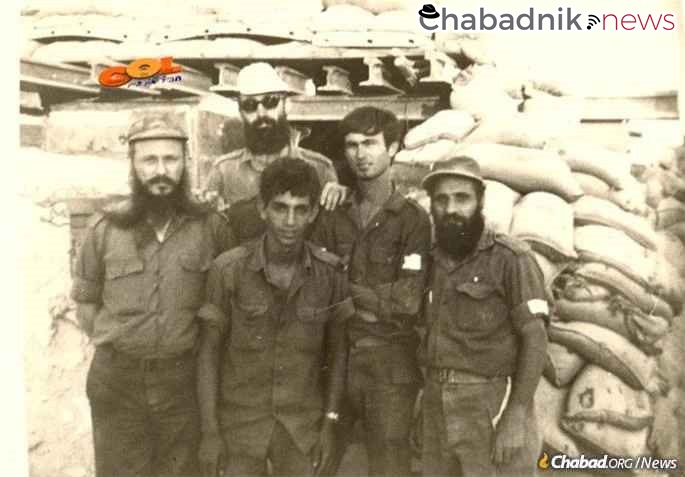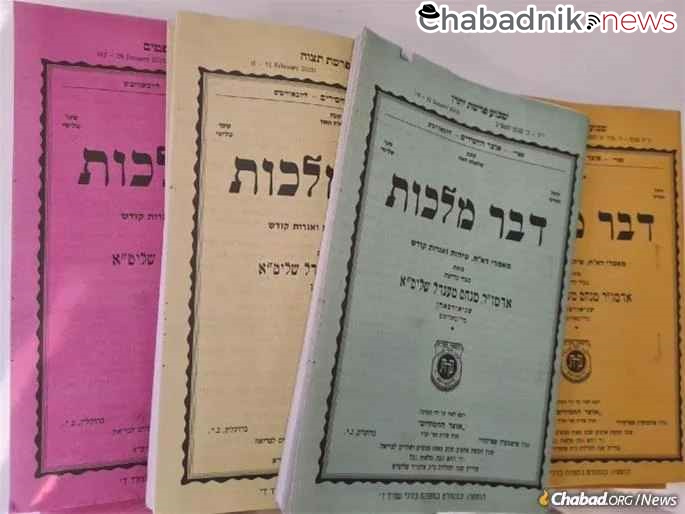Publisher of ‘Dvar Malchus’ was a Chabad fixture in Israel

Rabbi Tuvia Peles, an Israeli accountant, business manager and Chabad-Lubavitch Chassid who spread Chassidic teachings to the masses every week as publisher of the massively popular “Dvar Malchus” Torah-study booklet, passed away in Israel on Jan. 18, 2022 (16th of Shevat). He was 73 years old.
From an early age, Peles frequently corresponded with the Rebbe, Rabbi Menachem M. Schneerson, of righteous memory on all matters of life, both personal and communal. Although Peles never held an official title within the Chabad movement, at the Rebbe’s behest he spearheaded a host of projects in Israel, including programs geared at soldiers in the Israel Defense Forces. His professional life was never separate from his Jewish activism, thus as a long-time financial advisor to the United Kibbutz Movement organization, he used every opportunity to bring Jewish practice and tradition to both kibbutz leadership and members.
Tuvia Peles was born in Tel Aviv in 1948 to Rabbi Yakov and Rochel Peles. Both of his parents were involved in Jewish education, and his father established the Chabad yeshivahs in Israel’s Kiryat Gat and Rishon Letzion.
When Peles was only 4 years old, the Rebbe wrote to his father: “Surely, you will notify me about the educational plans for your son Tuvia.” The Rebbe expressed satisfaction when the older Peles notified him that Tuvia was enrolled at the newly founded Yeshiva Achei Temimim in Rishon Letzion.
When he was a teenager, his family moved to Kfar Chabad. At the age of 14, while a student at Yeshiva Tomchei Temimim in Lod, Peles wrote to the Rebbe that he would like to transfer to the New York branch of Tomchei Temimim. The Rebbe responded that he should devote himself totally to his learning and remain in the Israeli yeshivah for at least another few months, and the administration should then determine if he should transfer. Ultimately, it would be another six years before he traveled to the Rebbe in New York.

The Rebbe’s Envoy to the IDF
Upon reaching military age, Peles joined the IDF and served for three years in a religious battalion. During his service, he was stationed in Kibbutz Sde Boker to guard the desert residence of Israel’s founder and (retired) first prime minister, David Ben-Gurion, who enjoyed discussing religion and politics with the young bearded, conspicuously religious soldier.
In 1969, the 21-year-old IDF veteran embarked on his first journey to New York to experience the holidays of the Hebrew month of Tishrei 5730 in 770 with the Rebbe. Following Simchat Torah, he had his first private audience with the Rebbe, who gave him advice regarding a number of matters, including whether to remain and study in New York or return to Israel. Ultimately, he remained in New York to learn at the yeshivah in 770 for the better part of what was essentially a very formative year, during which the Rebbe expressed a unique interest in him.
During his time in New York, Peles discreetly volunteered to assist Rabbi Yoel Kahn, the principal oral scribe and editor of the Rebbe’s teachings, in editing and translating the Rebbe’s talks from Yiddish into Hebrew. Before he returned home in the summer of 1970, the Rebbe thanked him for the service.
The Rebbe then gave Peles a special assignment. Upon returning to Israel, he was to visit IDF soldiers stationed on the front lines in the Golan Heights, along the Jordan Valley and at the Suez Canal, to share the Rebbe’s heartfelt good wishes and encouragement with the soldiers guarding Israel’s borders during what was then the tense period of the War of Attrition.

The Rebbe gave him a bottle of spirits to (dilute and) distribute to the troops, as well as detailed instructions regarding what to convey to them—which included the importance for every soldier to put on tefillin, give some charity and study at least one line ofthe Mishnah every day.
The Rebbe added that he would personally provide the necessary funds for the trip and advised Peles to find a partner or two to join him on the mission, preferably fellow IDF veterans, and that they should seek permission to dress in military uniform for the duration of the mission.
Upon arriving in Israel, he immediately went about acquiring the necessary permits and gathered a few Chabad friends to accompany him. They then set about visiting dozens of IDF outposts in the Golan, the Jordan Valley and along the Suez Canal. Upon completion of the mission, Peles sent a detailed report to the Rebbe. Subsequently, the Rebbe sent thank-you letters to each of the IDF officers who helped facilitate the mission.
He married his wife, Rivkah (Zonis), in 1971, and the couple settled in Kfar Chabad.

A Chabad Insider in the Kibbutz Movement
In his professional life, Peles worked as an accountant and financial planner, but in keeping with what he’d internalized from the Rebbe’s teachings and approach, Peles viewed all of it—he constantly consulted with the Rebbe about his business matters—as an extension of the mission he’d been charged with by the Rebbe. One of his main clients was the United Kibbutz Movement, with whose members and leadership he built lifelong personal relationships.
Beginning in 1978 and throughout the 1980s, the Rebbe called for the printing of the Tanya—the foundational Chassidic work authored by Chabad’s founder, Rabbi Schneur Zalman of Liadi—in every locale where Jews reside. Peles convinced his friends in the kibbutz movement of the importance of Tanyas being printed and studied in various kibbutzim, and for them to provide the necessary funding for the project as well.
In one kibbutz, Ramat Yohanan just east of Haifa, the wording used on the title page of the Tanya, “Otzar Hachassidim (Chabad Publishing), Ramat Yohanan (branch),” caused a minor uproar among some kibbutz members who complained that it gave the impression that Chabad had turned the secular kibbutz into a branch of its movement. Peles asked the Rebbe whether he should wade in by responding to the complaints and the Rebbe, keeping to his rule of minimizing disagreement and discord, replied that since “engaging in controversy only begets further controversy,” he should not.
Shortly afterwards, the Rebbe sent Peles another letter along with a Tanya that had been recently printed on the island nation of Grenada following the 1983 invasion by U.S. troops to halt a Communist insurgency there. The Rebbe pointed out how the Tanya cover displayed the seal of the U.S. military and likewise indicated that it was printed by “Chabad Publishing, Grenada.” This ultimately served to calm the worried kibbutzniks.
Spreading the Rebbe’s Teachings
Beginning in the 1970s, Peles would make frequent trips to New York to visit the Rebbe, as often as once a month, and he even maintained a basement apartment close to 770. In the late 1980s , he would bring along Soviet immigrant students from the Chabad yeshiva in Ramle-Lod he helped found.
The Rebbe would regularly give out small bottles of vodka at his farbrengen gatherings in New York to visitors from communities around the world, for them to distribute in their home community when they returned and thereby symbolically unite them with the gathering in New York. On many occasions, before returning to Israel, the Rebbe would charge Peles with the task of delivering such bottles to distribute as Kos Shel Bracha (“cup of blessings”) to the Jews of Israel.
As a young man, Peles communicated with the Rebbe so frequently, says his son, Rabbi Moshe Peles of Chabad of Ashkelon, that he had the Rebbe’s office on speed dial on his home phone. His was also the first home in Kfar Chabad to have a fax machine in order to maintain rapid communication with New York.
Spreading the Rebbe’s teachings via various media in Israel was on the top of his mind. Through his connection with (the future Rebbe of Gur,) Rabbi Yakov Alter, Peles arranged for the Rebbe’s weekly talks to be printed in the popular Israeli weekly Hamodia newspaper.
In 1991, during the tense period of the Gulf War, when Israeli population centers were being threatened by Iraqi Scud missiles, possibly armed with chemical warheads, and feelings of anxiety and dread were being felt throughout Israel and worldwide, the Rebbe delivered a series of passionate talks in Hebrew that focused on appreciating and conveying the Jewish people’s spiritual standing in a positive light.
Seeing that these seminal talks of the Rebbe’s were not getting the level of circulation appropriate for their historic importance, Peles printed tens of thousands of transcripts of the talks in booklets and titled them “Dvar Malchus”.
In response to queries as to whether to leave Israel for safer havens, the Rebbe’s reply was clear and unequivocal: the Land of Israel is the safest place in the world. When asked about the gas-masks being distributed in Israel in anticipation of chemical warfare, the Rebbe opined that they would prove totally unnecessary. He also stated that the war would be over by Purim.
Once publicized, the Rebbe’s messages of confidence and trust had an immediate and lasting impact on an anxious Israel public and political leaders from across the spectrum would quote the Rebbe’s talks and advice, bringing a renewed sense of calm

Seeing the effect the Rebbe’s teachings had on so many, Peles decided to make the “Dvar Malchus” a permanent publication, which evolved to become a Swiss army knife of sorts for Torah learning on the go.
Each weekly edition comprises about 250 pages of densely packed Torah wisdom, including a maamar from the Rebbe with extensive explanation, an unedited sichah from the Rebbe, a sichah from Likkutei Sichos, the daily study portions for Tanya, HaYom Yom, and Maimonides’ Mishneh Torah, a portion of the teachings of each of the Chabad-Lubavitch Rebbeim, folios of Talmud for daily study, explanations for Pirkei Avot, two chapters of Tanach, and weekly Torah portion with Rashi’s commentary and Targum Onkelos.
The weekly booklets continue to grow in popularity30 years later. Each week, more than 70,000 copies are printed and are sent to hundreds of cities on all five continents, and people from every background can be seen on trains, buses, coffee shops and synagogues studying the astonishing wealth of wisdom in each issue.
“I lost a true friend this week,” wrote Israeli businessman, philanthropist and president of the World Congress of Bukharian Jews Lev Leviev. “I met Tuvia at the Israeli Diamond Exchange some 35 years ago and ever since then we’ve maintained a weekly study partnership together, even recently when he was in and out of the hospital. I saw before me a true Chassid. One who was wholeheartedly devoted to the Rebbe.
“My family and I merited to be his partners in the publication of the famous “Dvar Malchus” booklets, bringing the teachings of the Rebbe and Chabad chassidut in general to the masses,” Leviev added. “I recall how the endeavor initially began on a small scale and how many could be forgiven for (mistakenly) believing that Peles’s decision to leave thousands of copies at bus stations were a tad excessive.”
“Rabbi Tuvia’s life involved a deep commitment to the teachings of the Lubavitcher Rebbe and to the mission of spreading the Rebbe’s teachings. . . around the world,” wrote Israeli President Isaac Herzog in a condolence letter to the Peles family. Conveying the sentiments of many, Herzog mourned, “His absence will be felt by many in Israel and beyond.”
In addition to his wife, he is survived their children: Rabbi Shlomo Peles (Kfar Chabad, Israel); Esther Faktor (Kfar Chabad, Israel); Rabbi Shmuel Peles (Lauderhill, Fla.); Rabbi Yosef Peles (Kfar Chabad, Israel); Leizer Peles (Barcelona, Spain); Chana Edelkopf (Podgorica, Montenegro); Rabbi Moshe Peles (Ashkelon, Israel); Devorah Zigman (Jerusalem); Rabbi Levi Peles (Ashkelon, Israel); Rabbi Mendy Peles (Modi’in, Israel); Chaya Marilus of (Bern, Switzerland); Rabbi Yisrolik Peles (Nahariya, Israel); in addition to many grandchildren and great-grandchildren.



